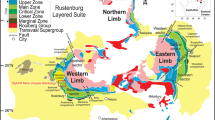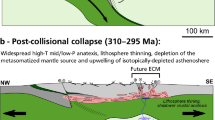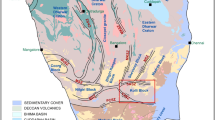Summary
Some Archaean granitoids occurring along the north-western and western edge of what is classically known as the Witwatersrand Basin have been hydrothermally altered in two different styles. Both styles - pervasive and vein-controlled alteration - are characterised by sulphide mineralisation as well as by thorium-, uranium-, gold- and REE-rich nodules of carbonaceous material (fly-speck carbon). All of the granitoids displaying these characteristic alteration styles are associated with secondary moderate-to high-salinity, Ca-rich fluid inclusions with low homogenisation temperatures in magmatic quartz and quartz veins. C-isotopes of the fly-speck carbon and the fluid composition of the associated fluid inclusions are typical of modified basin brines. Similar types of Ca-rich fluid inclusions were found in authigenic quartz and hydrothermal quartz veins from gold-bearing, hydrothermally altered sediments of the Witwatersrand Basin, although the salinities of the fluids in the basement granitiods are somewhat higher. The moderate- to high salinity of this inclusion fluid and its present composition is considered to be the result of modifications by fluid-rock interaction during transport and subsequent metamorphism within the Witwatersrand Basin. Available age data on the hydrothermally derived minerals in these granitoids range between 2.7 and 2.0 Ga indicating several fluid pulses, with fluids repeatedly expelled during the dewatering of the Witwatersrand Basin. These data are consistent with the conclusion that major parts of the alteration are the result of sediment dewatering which affected both the granitoids and the gold-bearing strata within the Witwatersrand Basin.
Zusammenfassung
Einige archaische Granitoide, die am nordwestlichen und westlichen Rand des Witwatersrand Beckens vorkommen, zeigen zwei Arten von hydrothermaler Überprägung. Beide Arten, pervasiv und gangförmig, sind mit einer Sulfidmineralisation und Thorium-, Uran-, Gold-, und SEE-reichen Knollen aus kohliger Substanz assoziiert. Alle Granitoide, die sich durch diese spezielle hydrothermale Überprägung auszeichnen, besitzen sekundäre moderat- bis hochsalinare, Ca-reiche Fluideinschlüsse mit niedrigen Homogenisierungstemperaturen in magmatischen und hydrothermalen Quarzen. Diese Fluide werden als modifizierte Beckenwässer gedeutet. Ähnliche Ca-reiche Fluideinschlüsse wurden in authigenen und hydrothermalen Quarzen in goldführenden, hydrothermal veränderten Sedimenten des Witwatersrand Beckens beobachtet, obwohl die Salinitäten der wässrigen Fluide in den Granitoiden noch höher sind. Die moderate bis hohe Salinität und die derzeitige Zusammensetzung der Einschlußfluide wird als eine Konsequenz aus der Fluid-Gesteinswechselwirkung, die während des Transportes im Becken stattfand, und der nachfolgenden Metamorphose angesehen. Vorläufige Altersdaten von den hydrothermal gebildeten Mineralen weisen auf mehrere hydrothermale Ereignisse während einer Zeitspanne zwischen 2.7 und 2.0 Ga hin. Während dieser Zeitspanne kam es durch Beckenentwässerung zu wiederholten Fluidschüben aus dem Becken in die Granitoide aufgrund lokaler tektonischer Ereignisse. Diese Daten deuten an, daß ein großer Teil der hydrothermalen Überprägung sowohl der Granitoide als auch der goldführenden Sedimente durch Formationswässer aus dem Witwatersrand Becken gebildet worden ist.
Similar content being viewed by others
References
Armstrong RA, Compston W, Retief EA, Williams IS, Welke HJ (1991) Zircon ion microprobe studies bearing on the age and evolution of the Witwatersrand triad. Precamb Res 53: 243–266
Barnicoat AC, Henderson IHC, Knipe RJ, Yardley BWD, Napier RW, Fox NPC, Kenyon AK, Muntigh DJ, Strydom D, Winkler KS, Lawrence SR, Cornford C (1997) Hydrothermal gold mineralization in the Witwatersrand basin. Nature 386: 820–824
Barton ES, Hallbauer DK (1996) Trace-element and U-Pb isotope compositions of pyrite types in the Proterozoic Black Reef, Transvaal Sequence, South Africa: implications on genesis and age. Chem Geol 133: 173–199
Barton JM Jr, Barton ES, Kröner A (1999) Age and isotopic evidence for the origin of the Archaean granitoid intrusives of the Johannesburg Dome, South Africa. J Afr Earth Sci 28 (in press)
Bodnar RJ, Binns PR, Hall DL (1989) Synthetic fluid inclusions, VI. Quantitative evaluation of the description behaviour of fluid inclusions in quartz at one atmosphere confining pressure. J Metam Geol 7: 229–242
Boer RH, Reimold WU, Kesler SE (1999) Conditions and timing of gold remobilization in the Ventersdorp Contact Reef, Witwatersrand Basin, South Africa. Mineral Petrol (this issue)
Coetzee DS, van Reenen DD, Roering C (1995) Quartz vein formation, metamorphism, and fluid inclusions associated with thrusting and bedding-parallel shear in Witwatersrand quartzites. S Afr J Geol 98: 371–382
Coward MP, Spencer RM, Spencer CE (1995) Development of the Witwatersrand Basin, South Africa. In:Coward MP, Ries AC (ed) Early Precambrian processes. Geol Soc Lond 95: 243–269
Drennan GR, Robb LJ, Meyer FM, Armstrong RA, Bruiyn H de (1990) The nature of the Archaean basement in the hinterland of the Witwatersrand Basin 11. A crustal profile west of the Welkom goldfield and comparisons with the Vredefort crustal profile. S Afr J Geol 93: 41–53
Drennan GR, Boiron MC, Cathelineau M, Robb LJ (1999) Characteristics and composition of post-depositional fluids in the Witwatersrand Basin. Mineral Petrol (this issue)
Frimmel HE (1997) Detrital origin of hydrothermal Witwatersrand gold - a review. Terra Nova 9: 192–197
Frimmel HE, Gartz VH (1997) Witwatersrand gold particle matches models of metamorphosed, hydrothermally altered placer deposits. Mineral Deposita 32: 523–530
Frimmel HE, LeRoex AP, Knight J, Minter WEL (1993) A case study of the postdepositional alteration of the Witwatersrand Basal Reef gold placer. Econ Geol 88: 249–265
Frimmel HE, Hallbauer DK, Gartz VH (1999) Gold mobilizing fluids in the Witwatersrand Basin — composition and possible sources. Mineral Petrol (this issue)
Gartz VH, Frimmel HE (1999) Complex metasomatism of an Archean placer in the Witwatersrand Basin, South Africa: the Venterdrop Contact Reef –a hydrothermal aquifer? Econ Geol 94: (in press)
Giusti L (1988) U-Pb isotopic data for sulfides of the Varkenskraal granite (western Transvaal, South Africa) and their bearing on the age and origin of uranium mineralization in the Witwatersrand Basin. Chem Geol 72: 311–328
Gize AP (1986) The development of a thermal mesophase in bitumens from high temperature ore deposits. Proc Denv Reg Explor Geol Soc Sym: 137–150
Hallbauer DK (1984) Archaean granitic sources for the detrital mineral assemblage in Witwatersrand conglomerates. Geocongress '84, Extended Abstracts. Geol Soc S Afr: 53–56
Hanor JS (1980) Dissolved methane in sedimentary brines: potential effect on PVT properties of fluid inclusions. Econ Geol 75: 603–609
Heyl AV (1983) Geologic characteristics of three major Mississippi Valley districts. Inter Conf on Mississippi Valley type lead-zinc deposits: 27–60
Klemd R, Barton JM Jr (1988) Mineralogy and geochemistry of the hydrothermally altered Archaean granodioritic rocks of the Ventersdorp Dome, Western Transvaal, South Africa. Mineral Petrol 38: 151–160
Klemd R, Hallbauer DK (1987) Hydrothermally altered peraluminous Archaean granites as a provenance model for Witwatersrand sediments. Mineral Deposita 22: 227–235
Klemd R, Hallbauer DK, Barton JM Jr (1986) Styles of hydrothermal alteration in granitoid rocks along the north-western margin of the Witwatersrand basin. Geocongress'86, Extended Abstracts. Geol Soc S Aft: 149–153
Klemd R, Hallbauer DK, Barton JM Jr (1989) Fluid inclusion studies of hydrothermally alterred Archaean granites around the Witwatersrand Basin. Mineral Petrol 40: 39–56
Klemd R, Widbers A, Halbauer DK, Barton JM Jr (1994) Evidence for the origen of hydrothermal alteration in granitoids after Witwatersrand deposition, South Africa. Aust J Earth Sci 41: 131–140
Klemd R, Bröcker M, Schramm J (1995) Characterisation of amphibolite-facies fluids of Variscan eclogites from the Orlica-Sniezniek dome (Sudetes, SW Polan). Chem Geol 119: 101–113
Mullis J, Dubessy J, Poty B, O'Neil J (1994) Fluid regimes during late stage of a continental collision: Physical, chemical, and stable isotope measurements and fluid inclusions in fissure quartz from a geotraverse through the Central Alps, Switzerland. Geochim Cosmochim Acta 58: 2239–2267
Phillips GN, Klemd R, Robertson NS (1988) Summary of some fluid inclusion data from the Witwatersrand Basin and surrounding granitoids. Memoirs Geol Soc India 11: 59–65
Phillips GN, Law JDM, Meyers RE (1989a) The Witwatersrand goldfields. 11. An origin for Witwatersrand gold during metamorphism and associated alteration. Monogr Econ Geol 6: 598–608
Phillips GN, Meyers RE, Law JDM, Bailey AC, Cadle AB, Beneke D, Giusti L (1989b) The Witwatersrand goldfields. 1. An origin for Witwatersrand gold during metamorphism and associated alteration. Monogr Econ Geol 6: 585–597
Phillips GN, Law JDM, Stevens G (1997) Alteration, heat, and Witwatersrand gold:111 years after Harrison and Langlaagte. S Afr J Geol 100: 377–392
Reimold WU, Meshik AP, Smits G, Pravdivtseva OV, Shkolyukov YA (1995) Fission xenon dating of Witwatersrand uraninites: implications for geological activity in the Central Kaapvaal Craton about 1 Ga ago. Geochim Cosmochim Acta 59: 5177–5190
Robb LJ, Meyer M (1987) The nature of the Archaean basement in the hinterland of the Witwatersrand basin. S Afr J Geol 90: 44–63
Robb LJ, Meyer M (1990) The nature of the Witwatersrand hinterland; conjectures on the source area problem. Econ Geol 85: 511–536
Robb LJ, Davis DW, Kamo SL, Meyer FM (1992) Ages of altered granites adjoining the Witwatersrand Basin with implication for the origin of gold and uranium. Nature 357: 677–680
Robb LJ, Landais P, Davis DW, Meyer FM (1994) Nodular organic matter in granites: implications for the origin of ‘kerogen’ in the Witwatersrand Basin, South Africa. Explor Mining Geol 3: 219–230
Robb LJ, Landais P, Drennan, GR, Dubessy J (1997) Petrographic, chemical and spectroscopic studies of carbonaceous matter in the Witwatersrand Basin, South Africa. University of the Witwatersrand, Econ Geol Res Unit-Inf Circ 312: 1–34
Roedder E (1984) Fluid inclusions. Rev Mineral 12: 1–644
Roering C, Barton JM Jr, Winter H, Dela R (1990) The Vredefort structure: a perspective with regard to new tectonic data from adjoining terranes. Tectonophysics 171: 7–22
Seward TM (1989) The hydrothermal chemistry of gold and its implication for ore formation: boiling and conductive cooling as examples. Monogr Econ Geol 6: 398–404
Stevens C, Boer R, Gibson R (1997) Metamorphism, fluid-flow, and gold mobilization in the Witwatersrand Basin: towards a unifying model. S Afr J Geol 100: 363–375
Sverjensky DA (1984) Oil field brines as ore-forming solutions. Econ Geol 79: 23–37
Wojcik KM, Goldstein RH, Walton AW (1994) History of diagenetic fluids in a distant foreland area, Middle and Upper Pennsylvanian, Cherokee basin, Kansas, USA: fluid inclusion evidence. Geochim Cosmochim Acta 58: 1175–1191
Author information
Authors and Affiliations
Rights and permissions
About this article
Cite this article
Klemd, R. A comparison of fluids causing post-depositional hydrothermal alteration in Archaean basement granitoids and the Witwatersrand Basin. Mineralogy and Petrology 66, 111–122 (1999). https://doi.org/10.1007/BF01161724
Received:
Accepted:
Issue Date:
DOI: https://doi.org/10.1007/BF01161724




